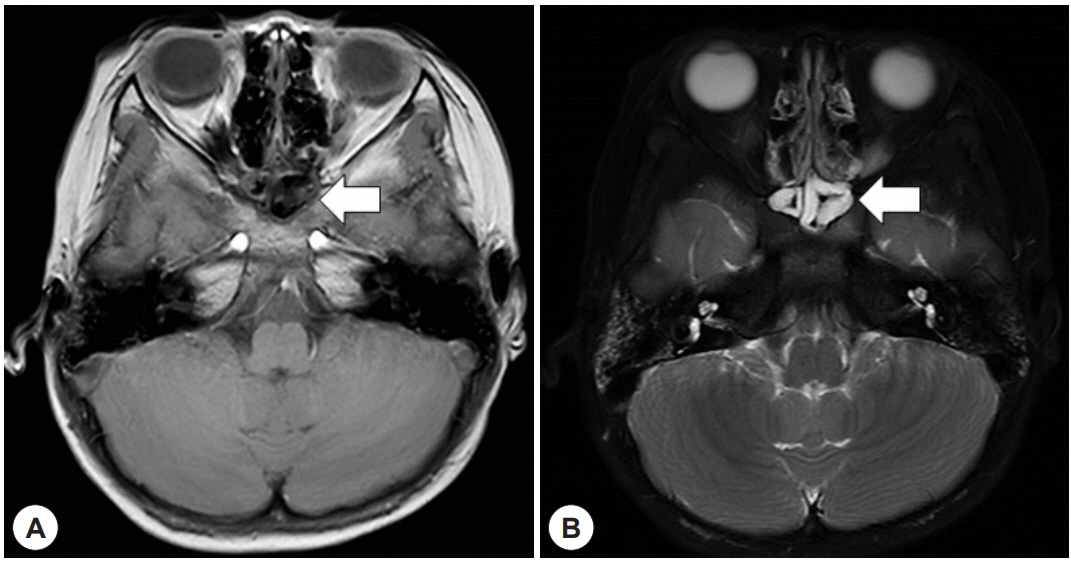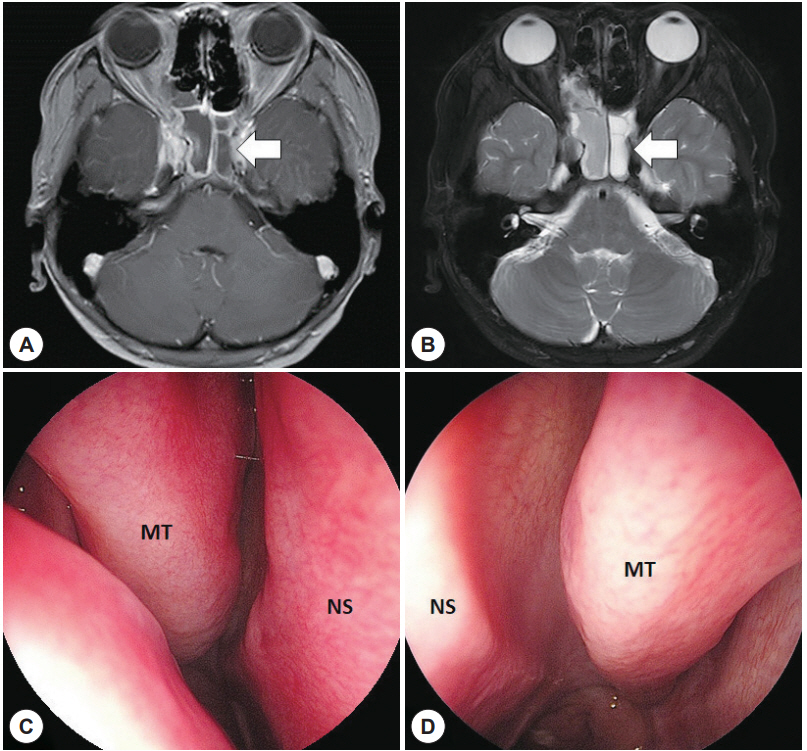J Rhinol.
2020 Nov;27(2):127-131. 10.18787/jr.2020.00326.
Two Cases of Acute Isolated Sphenoid Sinusitis in Children
- Affiliations
-
- 1Department of Otorhinolaryngology, Gyeongsang National University Hospital, Jinju, Korea
- KMID: 2508958
- DOI: http://doi.org/10.18787/jr.2020.00326
Abstract
- Acute isolated sphenoid sinusitis is a rare disease, and accounts for less than 3% of all sinusitis, especially in young children. Delayed diagnosis or misdiagnosis can occur frequently due to atypical clinical presentations. This can lead to serious complications because of the involvement of anatomically related intracranial structures. Therefore, nasal endoscopy, computed tomography (CT), and magnetic resonance imaging (MRI) are important diagnostic tools to confirm the diagnosis. We report two cases of a previously healthy 6-year-old girl and a 13-year-old boy, whose chief complaints were uncontrolled headache and high fever over 38°C. Physical examination and initial laboratory test results of blood, urine, and cerebrospinal fluid were normal. The diagnosis was made after a brain MRI revealed isolated sphenoid sinusitis. The girl was treated with third generation cephalosporins intravenously. The boy, however, had to undergo an emergent endoscopic sinus surgery as his headache and eyeball-pain symptoms did not resolve by medical treatment alone. Both cases had good outcomes, without neurological sequelae.
Keyword
Figure
Reference
-
1. Tan HK, Ong YK. Acute isolated sphenoid sinusitis. Ann Acad Med Singapore. 2004; 33(5):656–9.2. Monti A, Farini M, Katsanoulas C. Acute isolated sphenoid sinusitis in a 4-year-old child: a rare case with an atypical presentation. Signa Vitae-A Journal In Intensive Care And Emergency Medicine. 2008; 3(1):51–4.3. Caimmi D, Caimmi S, Labo E, Marseglia A, Pagella F, Castellazzi AM, et al. Acute isolated sphenoid sinusitis in children. Am J Rhinol Allergy. 2011; 25(6):e200–2.4. Ishak NL, Subha ST, Abu Bakar S. Isolated sphenoid sinusitis: a big headache. Malays Fam Physician. 2019; 14(1):29–30.5. Unlu HH, Aslan A, Goktan C, Egrilmez M. The intracranial complication of acute isolated sphenoid sinusitis. Auris Nasus Larynx. 2002; 29(1):69–71.6. Scuderi AJ, Harnsberger HR, Boyer RS. Pneumatization of the paranasal sinuses: normal features of importance to the accurate interpretation of CT scans and MR images. AJR Am J Roentgenol. 1993; 160(5):1101–4.7. Jang YJ, Kim SC. Pneumatization of the sphenoid sinus in children evaluated by magnetic resonance imaging. Am J Rhinol. 2000; 14(3):181–5.8. Elden LM, Reinders ME, Kazahaya K, Tom LW. Management of isolated sphenoid sinus disease in children: a surgical perspective. Int J Pediatr Otorhinolaryngol. 2011; 75(12):1594–8.9. Lahat E, Danieli J, Cohen H, Paret G, Barzilai A. Acute isolated sphenoid sinusitis in children. Pediatr Infect Dis J. 1997; 16(12):1180–2.10. Jeong JH, Kim K, Cho SH, Kim KR. Sphenoid sinus barotrauma after scuba diving. Am J Otolaryngol. 2012; 33(4):477–80.11. Vidic B. The postnatal development of the sphenoidal sinus and its spread into the dorsum sellae and posterior clinoid processes. Am J Roentgenol Radium Ther Nucl Med. 1968; 104(1):177–83.12. Proetz AW. The sphenoid sinus. Br Med J. 1948; 2(4569):243–5.13. Dyer SR, Thottam PJ, Saraiya S, Haupert M. Acute sphenoid sinusitis leading to contralateral cavernous sinus thrombosis: a case report. J Laryngol Otol. 2013; 127(8):814–6.14. Saitoh A, Beall B, Nizet V. Fulminant bacterial meningitis complicating sphenoid sinusitis. Pediatr Emerg Care. 2003; 19(6):415–7.15. Marseglia GL, Pagella F, Licari A, Scaramuzza C, Marseglia A, Leone M, et al. Acute isolated sphenoid sinusitis in children. Int J Pediatr Otorhinolaryngol. 2006; 70(12):2027–31.16. Wang PP, Ge WT, Ni X, Tang LX, Zhang J, Yang XJ, et al. Endoscopic Treatment of Isolated Sphenoid Sinus Disease in Children. Ear Nose Throat J. 2019; 98(7):425–30.17. Brook I. Bacteriology of acute and chronic sphenoid sinusitis. Ann Otol Rhinol Laryngol. 2002; 111(11):1002–4.18. Massoubre J, Saroul N, Vokwely JE, Lietin B, Mom T, Gilain L. Results of transnasal transostial sphenoidotomy in 79 cases of chronic sphenoid sinusitis. Eur Ann Otorhinolaryngol Head Neck Dis. 2016; 133(4):231–6.
- Full Text Links
- Actions
-
Cited
- CITED
-
- Close
- Share
- Similar articles
-
- Pure Isolated Sphenoid Sinusitis
- Clinical Analysis of Isolated Sphenoid Sinusitis
- Endoscopic Diagnosis and Treatment of Isolated Sphenoid Sinus Lesions
- A Case of Abducens Nerve Palsy Caused by Isolated Sphenoid Fungal Sinusitis
- Isolated Sphenoid Sinusitis withNontypeable Haemophilus influenzae Bacteremia in a Healthy Child




